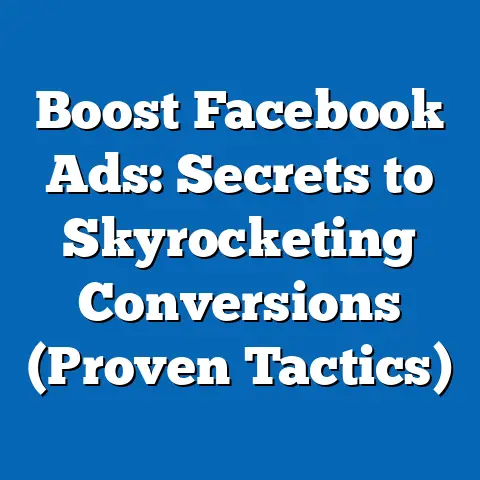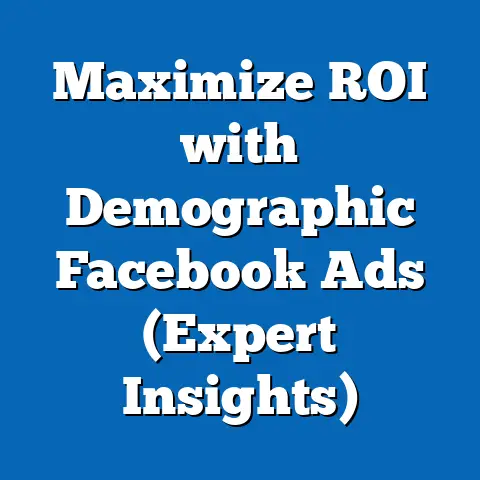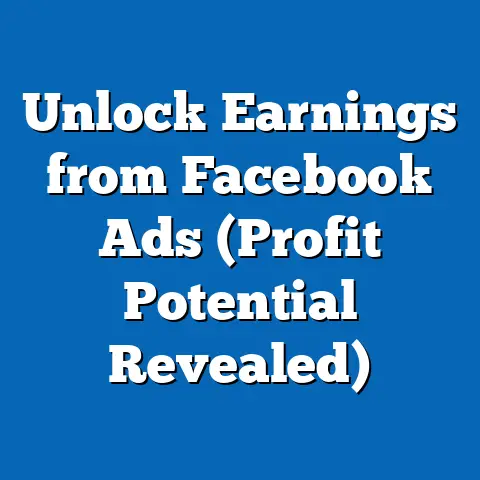Tired of Facebook Ads? (Unlock Proven Solutions)
Are you feeling the Facebook Ads fatigue? You’re not alone. It seems like just yesterday Facebook Ads were the golden ticket to online success, but lately, many businesses are finding their campaigns yielding less impressive results. I remember when I first started running Facebook ads for my small online store – the ROI was incredible! I was reaching a massive audience at a fraction of the cost of traditional advertising. But things have definitely changed. According to a recent study by HubSpot, over 61% of marketers say generating high-quality leads is their biggest challenge. And with the rise of other platforms and changing user behaviors, Facebook Ads aren’t always the answer anymore.
Understanding the Decline of Facebook Ads
So, what’s really going on with Facebook Ads? Why are they seemingly less effective than they used to be? There are a few key factors at play.
- Increased Competition and Ad Saturation: The sheer volume of ads on Facebook has exploded. Every business, big or small, is vying for the same attention. This means your ad is competing with countless others, making it harder to stand out and capture your audience’s interest. It’s like trying to be heard in a crowded stadium – you have to shout a lot louder just to be noticed.
- Algorithm Changes and Ad Targeting Challenges: Facebook’s algorithm is constantly evolving. These updates, while often intended to improve user experience, can make it more difficult for businesses to reach their target audience effectively. The algorithm’s focus on showing users content they’re most likely to engage with can sometimes bury ads, especially if they’re not highly relevant or engaging. I’ve personally experienced this frustration when I’ve meticulously crafted a campaign, only to see its reach plummet after an algorithm update.
- Growing Consumer Skepticism: Let’s face it, people are becoming more savvy about ads. They’re bombarded with marketing messages all day, every day, and they’re increasingly skeptical of the claims made in those ads. This means your ad needs to be genuinely compelling, authentic, and relevant to break through the noise and earn their trust.
- Data Privacy Concerns: With growing concerns about data privacy, users are becoming more cautious about the information they share online. This can impact the effectiveness of ad targeting, as businesses may have less data to work with to reach the right audience.
Let’s look at a real-world example. I worked with a local bakery that relied heavily on Facebook Ads to promote their daily specials. Initially, their campaigns were highly successful, driving significant foot traffic to their store. However, over time, they noticed a sharp decline in engagement and sales. After analyzing their campaign data, we discovered that their ads were being shown to a broader audience than intended, and the cost per click had increased dramatically. The bakery was essentially paying more to reach fewer relevant customers. This demonstrates how increased competition and algorithm changes can negatively impact even well-established Facebook ad campaigns.
Key Takeaway: The decline of Facebook Ads isn’t necessarily a sign that the platform is dead. It’s a reflection of a changing digital landscape where competition is fierce, algorithms are unpredictable, and consumers are more discerning. The key is to understand these challenges and adapt your approach accordingly.
Exploring Alternative Advertising Channels
If Facebook Ads aren’t delivering the results you need, it’s time to explore alternative advertising channels. The good news is, there are plenty of options to choose from, each with its own unique strengths and target audience.
-
Google Ads: Google Ads is a powerful platform that allows you to reach potential customers when they’re actively searching for products or services like yours. Unlike Facebook, where you’re interrupting users with ads while they’re scrolling through their feed, Google Ads allows you to target users based on their search queries. This can be particularly effective for businesses in industries like e-commerce, home services, and professional services.
For example, if you’re a plumber, you can target users who search for “emergency plumber near me” or “leaky faucet repair.” This ensures that your ad is shown to people who are actively looking for your services. I’ve seen businesses achieve incredible ROI with Google Ads by focusing on highly specific keywords and optimizing their landing pages for conversions. * Instagram Ads: With its focus on visual content and influencer marketing, Instagram Ads can be a great option for businesses targeting a younger audience or those in industries like fashion, beauty, and travel. Instagram allows you to create visually appealing ads that blend seamlessly into users’ feeds. You can also leverage influencer partnerships to reach a wider audience and build trust with potential customers.
I worked with a clothing boutique that saw a significant increase in sales after launching Instagram Ads campaigns featuring local fashion bloggers. The combination of high-quality product photos and influencer endorsements proved to be a winning formula. * TikTok Ads: TikTok is the fastest-growing social media platform, and it’s quickly becoming a popular advertising channel for businesses targeting Gen Z and younger millennials. TikTok Ads are all about short-form video content that’s engaging, entertaining, and authentic. If you can create videos that capture users’ attention and resonate with their sense of humor, you can achieve viral success on TikTok.
I’ve seen businesses in the food and beverage industry create incredibly successful TikTok Ads by showcasing recipes, product demos, and behind-the-scenes content. The key is to embrace the platform’s unique culture and create content that feels natural and organic. * LinkedIn Ads: LinkedIn Ads is the go-to platform for B2B advertising. It allows you to target professionals based on their job title, industry, company size, and other demographic factors. LinkedIn Ads can be particularly effective for businesses selling software, consulting services, or other products and services targeted at professionals.
I’ve worked with software companies that have generated high-quality leads and closed lucrative deals through LinkedIn Ads campaigns targeting decision-makers in specific industries. The platform’s professional targeting capabilities make it ideal for reaching a niche audience with a high purchasing power.
Google Ads: Google Ads is a powerful platform that allows you to reach potential customers when they’re actively searching for products or services like yours. Unlike Facebook, where you’re interrupting users with ads while they’re scrolling through their feed, Google Ads allows you to target users based on their search queries. This can be particularly effective for businesses in industries like e-commerce, home services, and professional services.
For example, if you’re a plumber, you can target users who search for “emergency plumber near me” or “leaky faucet repair.” This ensures that your ad is shown to people who are actively looking for your services. I’ve seen businesses achieve incredible ROI with Google Ads by focusing on highly specific keywords and optimizing their landing pages for conversions. * Instagram Ads: With its focus on visual content and influencer marketing, Instagram Ads can be a great option for businesses targeting a younger audience or those in industries like fashion, beauty, and travel. Instagram allows you to create visually appealing ads that blend seamlessly into users’ feeds. You can also leverage influencer partnerships to reach a wider audience and build trust with potential customers.
I worked with a clothing boutique that saw a significant increase in sales after launching Instagram Ads campaigns featuring local fashion bloggers. The combination of high-quality product photos and influencer endorsements proved to be a winning formula. * TikTok Ads: TikTok is the fastest-growing social media platform, and it’s quickly becoming a popular advertising channel for businesses targeting Gen Z and younger millennials. TikTok Ads are all about short-form video content that’s engaging, entertaining, and authentic. If you can create videos that capture users’ attention and resonate with their sense of humor, you can achieve viral success on TikTok.
I’ve seen businesses in the food and beverage industry create incredibly successful TikTok Ads by showcasing recipes, product demos, and behind-the-scenes content. The key is to embrace the platform’s unique culture and create content that feels natural and organic. * LinkedIn Ads: LinkedIn Ads is the go-to platform for B2B advertising. It allows you to target professionals based on their job title, industry, company size, and other demographic factors. LinkedIn Ads can be particularly effective for businesses selling software, consulting services, or other products and services targeted at professionals.
I’ve worked with software companies that have generated high-quality leads and closed lucrative deals through LinkedIn Ads campaigns targeting decision-makers in specific industries. The platform’s professional targeting capabilities make it ideal for reaching a niche audience with a high purchasing power.
According to a recent report by Statista, Google accounted for 28.8% of the global digital ad spending in 2023, followed by Meta (Facebook) with 20.7%. While Facebook still holds a significant share, the rise of other platforms like TikTok and Amazon Ads is rapidly changing the landscape.
Key Takeaway: Don’t put all your eggs in one basket. Exploring alternative advertising channels can help you reach a wider audience, diversify your marketing efforts, and potentially achieve a higher ROI. Consider your target audience, industry, and budget when choosing the right platforms for your business.
Strategies for Optimizing Facebook Ad Performance
Okay, so you’re not ready to abandon Facebook Ads entirely. That’s perfectly understandable. Despite the challenges, Facebook still boasts a massive user base and powerful targeting capabilities. The key is to optimize your campaigns to get the most out of your ad spend. Here are some proven strategies to help you improve your Facebook Ad performance:
-
A/B Testing: A/B testing is the process of comparing two versions of an ad to see which one performs better. You can test different ad creatives, headlines, calls to action, and target audiences to identify the elements that resonate most with your audience. I always recommend starting with small tests to identify the most impactful changes before scaling your campaigns.
For example, you could test two different headlines for the same ad to see which one generates more clicks. Or you could test two different images to see which one captures more attention. The possibilities are endless. * Audience Segmentation: Instead of targeting a broad audience, try segmenting your audience based on demographics, interests, behaviors, and other factors. This allows you to create more targeted ad sets that are highly relevant to specific groups of people.
I’ve found that creating custom audiences based on website visitors, email subscribers, and past purchasers can significantly improve ad performance. By targeting users who have already interacted with your business, you’re more likely to generate conversions. * Leveraging Retargeting: Retargeting is the process of showing ads to users who have previously interacted with your website, app, or Facebook page. This is a highly effective strategy for re-engaging potential customers who may have abandoned their shopping cart or visited a specific product page.
I’ve seen e-commerce businesses achieve incredible results with retargeting campaigns that offer discounts or free shipping to users who abandoned their shopping carts. This is a great way to recover lost sales and drive conversions. * Utilizing Facebook’s Analytics Tools: Facebook offers a wealth of analytics tools that can help you track your ad performance, identify areas for improvement, and gain insights into your audience. Pay close attention to metrics like click-through rate (CTR), cost per click (CPC), conversion rate, and return on ad spend (ROAS).
I always recommend setting up custom dashboards to track the metrics that are most important to your business. This allows you to quickly identify trends and make data-driven decisions.
A/B Testing: A/B testing is the process of comparing two versions of an ad to see which one performs better. You can test different ad creatives, headlines, calls to action, and target audiences to identify the elements that resonate most with your audience. I always recommend starting with small tests to identify the most impactful changes before scaling your campaigns.
For example, you could test two different headlines for the same ad to see which one generates more clicks. Or you could test two different images to see which one captures more attention. The possibilities are endless. * Audience Segmentation: Instead of targeting a broad audience, try segmenting your audience based on demographics, interests, behaviors, and other factors. This allows you to create more targeted ad sets that are highly relevant to specific groups of people.
I’ve found that creating custom audiences based on website visitors, email subscribers, and past purchasers can significantly improve ad performance. By targeting users who have already interacted with your business, you’re more likely to generate conversions. * Leveraging Retargeting: Retargeting is the process of showing ads to users who have previously interacted with your website, app, or Facebook page. This is a highly effective strategy for re-engaging potential customers who may have abandoned their shopping cart or visited a specific product page.
I’ve seen e-commerce businesses achieve incredible results with retargeting campaigns that offer discounts or free shipping to users who abandoned their shopping carts. This is a great way to recover lost sales and drive conversions. * Utilizing Facebook’s Analytics Tools: Facebook offers a wealth of analytics tools that can help you track your ad performance, identify areas for improvement, and gain insights into your audience. Pay close attention to metrics like click-through rate (CTR), cost per click (CPC), conversion rate, and return on ad spend (ROAS).
I always recommend setting up custom dashboards to track the metrics that are most important to your business. This allows you to quickly identify trends and make data-driven decisions.
Crafting compelling ad copy and visuals is also crucial for success on Facebook. Your ad should be visually appealing, relevant to your target audience, and offer a clear call to action. Use high-quality images and videos that capture attention and tell a story. Write concise, persuasive copy that highlights the benefits of your product or service.
Key Takeaway: Optimizing your Facebook Ad campaigns requires a data-driven approach. By A/B testing different elements, segmenting your audience, leveraging retargeting, and utilizing Facebook’s analytics tools, you can improve your ad performance and achieve a higher ROI. Don’t be afraid to experiment and try new things. The digital landscape is constantly evolving, so you need to be agile and adaptable.
Building a Holistic Marketing Strategy
Ultimately, successful advertising isn’t just about running ads. It’s about building a holistic marketing strategy that integrates all your marketing efforts and creates a cohesive brand experience for your customers. Facebook Ads should be just one piece of the puzzle.
-
Content Marketing: Content marketing is the process of creating and sharing valuable, relevant, and consistent content to attract and engage your target audience. This can include blog posts, articles, videos, infographics, and other types of content. Content marketing can help you build brand awareness, establish thought leadership, and drive traffic to your website.
I’ve seen businesses successfully integrate content marketing with their Facebook Ads campaigns by promoting their blog posts and videos to a targeted audience. This can help you generate leads and build a relationship with potential customers. * SEO (Search Engine Optimization): SEO is the process of optimizing your website and content to rank higher in search engine results pages (SERPs). This can help you drive organic traffic to your website and reach potential customers who are actively searching for products or services like yours.
I always recommend conducting keyword research to identify the terms that your target audience is using to search for your business. Then, optimize your website and content around those keywords to improve your search engine rankings. * Email Marketing: Email marketing is the process of sending targeted emails to your subscribers to promote your products or services, share valuable content, and build relationships. Email marketing can be a highly effective way to nurture leads, drive conversions, and retain customers.
I’ve seen businesses achieve incredible results with email marketing campaigns that segment their subscribers based on their interests and behaviors. This allows you to send highly personalized emails that are more likely to resonate with your audience. * Customer Feedback and Data Analysis: Gathering customer feedback and analyzing your marketing data is crucial for refining your overall marketing approach. Use surveys, polls, and social listening tools to understand your customers’ needs and preferences. Analyze your website traffic, ad performance, and email marketing data to identify areas for improvement.
I always recommend creating a customer feedback loop that allows you to continuously gather feedback and make data-driven decisions. This will help you optimize your marketing efforts and create a better experience for your customers. * Building Community and Fostering Organic Engagement: Focus on building a community around your brand and fostering organic engagement on social media. This means creating valuable content, engaging with your followers, and responding to their questions and comments.
I’ve seen businesses successfully build communities on Facebook and other social media platforms by creating groups, hosting events, and running contests. This can help you build brand loyalty and drive organic growth.
Content Marketing: Content marketing is the process of creating and sharing valuable, relevant, and consistent content to attract and engage your target audience. This can include blog posts, articles, videos, infographics, and other types of content. Content marketing can help you build brand awareness, establish thought leadership, and drive traffic to your website.
I’ve seen businesses successfully integrate content marketing with their Facebook Ads campaigns by promoting their blog posts and videos to a targeted audience. This can help you generate leads and build a relationship with potential customers. * SEO (Search Engine Optimization): SEO is the process of optimizing your website and content to rank higher in search engine results pages (SERPs). This can help you drive organic traffic to your website and reach potential customers who are actively searching for products or services like yours.
I always recommend conducting keyword research to identify the terms that your target audience is using to search for your business. Then, optimize your website and content around those keywords to improve your search engine rankings. * Email Marketing: Email marketing is the process of sending targeted emails to your subscribers to promote your products or services, share valuable content, and build relationships. Email marketing can be a highly effective way to nurture leads, drive conversions, and retain customers.
I’ve seen businesses achieve incredible results with email marketing campaigns that segment their subscribers based on their interests and behaviors. This allows you to send highly personalized emails that are more likely to resonate with your audience. * Customer Feedback and Data Analysis: Gathering customer feedback and analyzing your marketing data is crucial for refining your overall marketing approach. Use surveys, polls, and social listening tools to understand your customers’ needs and preferences. Analyze your website traffic, ad performance, and email marketing data to identify areas for improvement.
I always recommend creating a customer feedback loop that allows you to continuously gather feedback and make data-driven decisions. This will help you optimize your marketing efforts and create a better experience for your customers. * Building Community and Fostering Organic Engagement: Focus on building a community around your brand and fostering organic engagement on social media. This means creating valuable content, engaging with your followers, and responding to their questions and comments.
I’ve seen businesses successfully build communities on Facebook and other social media platforms by creating groups, hosting events, and running contests. This can help you build brand loyalty and drive organic growth.
For instance, a local coffee shop I worked with successfully integrated Facebook Ads into a broader marketing strategy by combining targeted ads with engaging social media content, email marketing, and in-store promotions. They ran Facebook Ads to promote their new seasonal drinks, while simultaneously sharing behind-the-scenes content on their Facebook page, sending out email newsletters with exclusive coupons, and offering in-store discounts to customers who followed them on social media. This holistic approach not only drove foot traffic to their store but also built a loyal customer base that kept coming back for more.
Key Takeaway: A successful marketing strategy is more than just running ads. It’s about creating a cohesive brand experience that integrates all your marketing efforts. By combining Facebook Ads with content marketing, SEO, email marketing, customer feedback, and community building, you can create a powerful marketing engine that drives real results.
Conclusion
Navigating the world of Facebook Ads can be challenging, especially in today’s competitive digital landscape. But don’t let the frustrations discourage you. By understanding the reasons behind the decline in effectiveness, exploring alternative advertising channels, optimizing your Facebook campaigns, and building a holistic marketing strategy, you can overcome these challenges and achieve your marketing goals.
Remember, the key is to be adaptable, data-driven, and focused on creating a valuable experience for your customers. Don’t be afraid to experiment, try new things, and continuously refine your approach based on the results you’re seeing. The digital landscape is constantly evolving, so you need to be agile and willing to adapt.
Take action on the solutions provided in this article and adapt your advertising approach to meet the evolving landscape of digital marketing. The future of advertising is about creating meaningful connections with your audience and providing them with value. Embrace this approach, and you’ll be well on your way to success.






